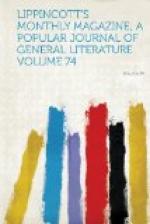The fiddle-maker Stainer
Goes whistling on his way:
A master like to Stainer
Is not found every day.
He passes lofty beech trees,
And old oaks stout and good,
Because that which he seeks for
Grows not in every wood.
But yonder in the sunshine,
Above the dark green shade,
Behold a hazel-fir tree—
“Joergel,” said I, “as you are a forester and know all the trees in the wood, I wish you would show me a hazel-fir tree.”
“Wohl gut,” he replied. “Higher up the chances are small but what we pass one. I only pray the gracious Fraeulein to say those verses over again.”
When I had done so he wished to know whether the fiddle-maker Stainer were a real man or no.
“Why, good Joergel,” I replied, “he was a real Tyroler like yourself, only you are not likely to have met with him, seeing that he died and was buried some two hundred years ago. Yes, a very real man, who did his work well, but to little profit. He was a peasant lad of Absam, who, probably going to Innspruck whilst the archduke Leopold and his Italian consort, Claudia dei Medici, kept their gay court there, thought Italian violins were harsh and unsatisfactory in tone, and so quietly worked out one of a different make from his own principles; which has since gained for him the name of ’the father of the German violin.’ He never expected to earn such a title. He had begun making violins when he was twenty: he worked very slowly, only made a few, and sold them at a moderate price to the foreign dealers who came to the fairs at Hall. They soon became asked after, for they excelled as instruments from the first moment that they were touched, and retain to this day the clearest and the fullest notes, like the middle tones of the flute, wonderfully sympathetic and rich. The peculiar excellency is probably owing to the extreme care which he showed in the selection of the wood. He used the hazel-fir tree, it is said. He selected the wood himself, striking the trunk with his hammer to hear its tones before he felled it. He would wander for days through the mountain forests searching suitable trees. He studied each one, and only chose that which exactly answered his purpose—generally those of which the topmost boughs were already dead.
“When wood was being precipitated down the mountain-slides, he would seat himself in some safe spot near at hand, and listen to the different tones which the trunks uttered as they struck against the rocks in their fall. He chose from these ‘singing trees’ those which pleased his ear the most. He was also particular about the rings on the stems of the felled trees. They must be harmonious and regular, neither too near nor too far apart. For those portions of the violin which were made in separate pieces he used very old wood, preferring old inner doors and wainscoting.




